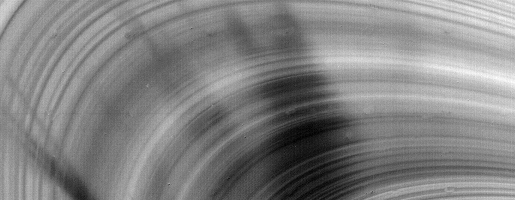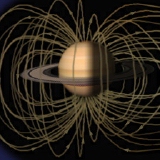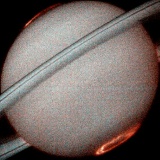 |
||
|
Saturn's magnetic field generates spokes within the
ring system.
|
||
| THE MAGNETIC FIELD OF SATURN | ||
| The existence of a magnetic field about Saturn was verified when in 1979 the Pioneer 11 spacecraft located the bow-shock, the outer sunward facing limit of the field. Travelling into the field, Pioneer returned information about its structure and properties. Pioneer found that the magnetic field strength was 600 times that of Earth's. Though weaker, in terms of structure, the field is very similar to Jupiter's. | ||
| Saturn spins rapidly, taking just under 11 hours to make a complete rotation. This causes the metallic hydrogen within to move. The flow of metallic liquid generates electric currents in the same way as a dynamo, a machine which converts mechanical energy to electrical energy. The electric current produces a field. The magnetic field opposes the force which has set it up, otherwise it would increase in strength perpetually. | ||
| The presence of a magnetic field is the main piece of evidence that Saturn has a liquid and mobile interior. It is estimated from the field that the conducting part of Saturn occupies about 50% of its radius, compared to Jupiter which has a much stronger field and has an electrical core which dominates 70% of its cross-section. | ||
| Saturn's field is dipolar like Earth's and Jupiter's. It behaves as if a large and powerful magnet runs through the middle of the planet. Saturn's field, however, is opposite to that of Earth's. In other words, the alignment of the north and south magnetic poles is reversed. Field lines run from the northern pole and re-enter at Saturn's southern pole. | ||
| The magnetic field is aligned with the planet's equator and is not tilted like Earth's or Jupiter's. The poles are unusual in that they have a stronger field than would be expected from a simple dipole field. There is also an imbalance between the poles. The field strength at the north pole is 0.8 gauss whereas at the south pole a value of 0.7 gauss is recorded. The differences are thought to be caused by variation in the flow currents within Saturn brought about by its rapid rotation and low density. | ||
| Saturn's magnetosphere, within which the magnetic field exerts an influence, extends to a distance of about 1.2 million kilometres on the sunward side. The magnetosphere is enclosed within an envelope called the magnetosheath. Charged particles from the Sun are deflected by the magnetic field and a bow shock is generated. It is like the bow wave formed at the front of a moving ship. The front end of the magnetosphere meets the solar wind and has a convex face called the magnetopause. The trailing part of the magnetosphere, called the magnetotail, is drawn out and streamlined by the solar wind. | ||
 Saturn's magnetosphere. |
||
| The distance of the magnetopause boundary from Saturn varies slightly, depending on the strength of the solar wind. Coincidentally, the orbit of Titan is located at such a distance from Saturn that Titan sometimes finds itself outside the magnetosphere, sometimes within. | ||
| Particles which carry a charge at the top of Titan's atmosphere interact with Saturn's magnetic field and spiral along the field lines in the same way as particles do within the magnetospheres of Earth and Jupiter. The inner moons absorb some of these particles, creating holes, or gaps, in the distribution of particles about the planet.Recent Hubble Space Telescope pictures show Saturn's aurora in ultraviolet light at both north and south poles. | ||
| The Saturnian aurora is generated by ionised particles captured from the solar wind and from Titan. These travel down the magnetic field lines to the poles where they interfere with the atmosphere. The interference creates auroral displays similar to the aurora borealis (northern lights) and aurora australis (southern lights) on Earth. | ||
 Hubble Space Telescope ultraviolet image of Saturn's polar aurorae. |
||
|
|
||